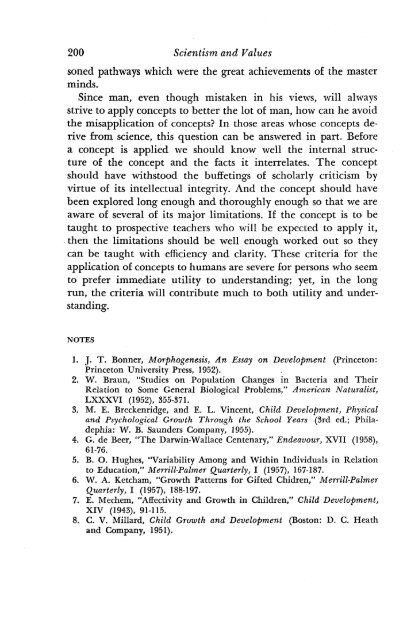Scientism and Values.pdf - Ludwig von Mises Institute
Scientism and Values.pdf - Ludwig von Mises Institute
Scientism and Values.pdf - Ludwig von Mises Institute
You also want an ePaper? Increase the reach of your titles
YUMPU automatically turns print PDFs into web optimized ePapers that Google loves.
200 <strong>Scientism</strong> <strong>and</strong> <strong>Values</strong><br />
soned pathways which were the great achievements of the master<br />
minds.<br />
Since man, even though mistaken in his views, will always<br />
strive to apply concepts to better the lot of man, how can he avoid<br />
the misapplication of concepts? In those areas whose concepts derive<br />
from science, this question can be answered in part. Before<br />
a concept is applied we should know well the internal structure<br />
of the concept <strong>and</strong> the facts it interrelates·. The concept<br />
should have withstood the buffetings of scholarly criticism by<br />
virtue of its intellectual integrity. And the concept should have<br />
been explored long enough <strong>and</strong> thoroughly enough so that we are<br />
aware of several of its major limitations. If the concept is to be<br />
taught to prospective teachers who will be expected to apply it,<br />
. then the limitations should be well enough worked out so they<br />
can be taught with efficiency <strong>and</strong> clarity. These criteria for the<br />
application of concepts to humans are severe for persons who seem<br />
to prefer immediate utility to underst<strong>and</strong>ing; yet, in the long<br />
run, the criteria will contribute much to both utility <strong>and</strong> underst<strong>and</strong>ing.<br />
NOTES<br />
1. J. T. Bonner, Morphogenesis, An Essay on Development (Princeton:<br />
Princeton University Press, 1952).<br />
2. W. Braun, "Studies on Population Changes in Bacteria <strong>and</strong> Their<br />
Relation to Some General Biological Problems," American Naturalist,<br />
LXXXVI (1952), 355-371.<br />
3. M. E. Breckenridge, <strong>and</strong> E. L. Vincent, Child Development, Physical<br />
<strong>and</strong> Psychological Growth Through the School Years (3rd ed.; Philadephia:<br />
W. B. Saunders Company, 1955).<br />
4. G. de Beer, "The Darwin-Wallace Centenary," Endeavour, XVII (1958),<br />
61-76.<br />
5. B. O. Hughes, "Variability Among <strong>and</strong> Within Individuals in Relation<br />
to Education," Merrill-Palmer Quarterly, I (1957), 167-187.<br />
6. W. A. Ketcham, "Growth Patterns for Gifted Chidren," Merrill-Palmer<br />
Quarterly, I (1957), 188-197.<br />
7. E. Mechem, "Affectivity <strong>and</strong> Growth in Children," Child Development,<br />
XIV (1943), 91-115.<br />
8. C. V. Millard, Child Growth <strong>and</strong> Development (Boston: D. C. Heath<br />
<strong>and</strong> Company, 1951).
















